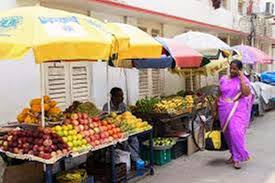27 Jul 2022 Street vendors

- Recently, the Minister of Housing and Urban Affairs addressed the 6th meeting of the National Association of Street Vendors of India (NASVI) on the topic “From Encroachers to Self-Employed”.
Street Vendors:
- Street vendors are individuals who offer to sell goods to the public on a large scale without a permanent built structure to sell the goods.
- Street vendors permanently occupy pavements or other public/private places to sell goods or temporarily move their goods from one place to another carrying their goods in push carts or head baskets.
Population
- The number of street vendors has increased significantly in major cities around the world, especially in developing countries in Asia, Latin America and Africa.
- Around 49.48 lakh street vendors have been identified in India.
- Uttar Pradesh has the highest number of 8.49 lakhs, followed by Madhya Pradesh with 7.04 lakhs street vendors.
- There are only 72,457 street vendors in Delhi.
- No street vendor has been identified in Sikkim.
Constitutional Provisions:
Right to do business:
- Article 19(1) (g) gives fundamental right to Indian citizens to practice any profession or to carry on business, trade or commerce.
Equality before the law:
- According to Article 14 of the Constitution, the State shall not deny to any person equality before the law or equal protection of the laws within the territory of India.
Social justice:
- The Preamble of the Indian Constitution states that India is a sovereign, socialist, secular democratic republic and shall ensure social, economic and political justice, equality of status and opportunity for all its citizens.
Directive Principles:
- Under Article 38(1), the state has to direct the promotion of the welfare of the people by ensuring a social order, in which social, economic and political justice will be ensured in the national institutions.
- Article 38(2) directs ‘to reduce inequalities in income status, facilities and opportunities’.
- Article 39 (A) directs the state to formulate policy to ensure that citizens, men and women alike, have the right to access to adequate means of livelihood.
- Article 41 specifically provides for the ‘right to work’ within the limits of the economic capacity of the state.
Reasons for increasing the number of street vendors:
- First, poverty in rural areas as well as lack of gainful employment have forced people to move out of their villages in search of a better life in the cities.
- These migrants lack the skills or education to get better wages, secure employment in the organized sector, so they have to settle for work in the unorganized sector.
- Second, there is another section of the population in the country who is forced to go to the unorganized sector for employment.
- These are the workers who were once employed in the organized sector.
- They lost their jobs due to closure, shrinkage or merger of industries and they or their family members had to look for low wages work in the unorganized sector to make a living.
Challenges before Street Vendors:
Space constraints:
- The master plans prepared for our cities do not allocate space to vendors/hawkers, as the planners imitate the western concept of marketing ignoring Indian traditions.
Troubleshooting multiple authorizations:
- Vendors have to deal with many authorities- Municipal Corporation, Police (Station as well as Traffic), Regional Development Authority, District Administration, Local Panchayat etc.
Exploitation and Extortion:
- In many cases the positive steps taken by one authority get nullified because of the actions of others.
- Instead of regulating vendors, municipal corporations regard them as an encroacher and a nuisance, their policies and actions aimed more at removing and harassing them rather than regulating them.
Frequent evictions:
- Regular evictions are carried out by the district or municipal administration.
- They fear the action of the eviction team known locally by different names.
Extortion racket:
- Cases of ‘extortion tax’ and ‘haft collection’ are common.
- In many cities sellers have to pay enough money to run their business.
Government Initiatives for Street Vendors:
Svanidhi Scheme:
- SVANidhi scheme was launched to benefit more than 50 lakh street vendors of urban areas, including people from adjoining urban/rural areas.
- It aims to promote digital transactions through cash-back incentives up to an amount of Rs 1,200 per annum.
National Association of Street Vendors of India:
- NASVI is an organization working to protect the livelihood rights of thousands of street vendors across the country.
- The main objective of setting up NASVI was to bring together street vendor organizations in India so that collective efforts can be made for changes at a large scale.
The Street Vendors (Protection of Livelihoods and Regulation of Street Vending) Act, 2014:
- This act was enacted to regulate and protect the rights of street vendors in public areas.
- The Act defines a street vendor as a person who sells goods or services of everyday use to the general public, in any public place or private area, by means of a temporary structure or by moving from place to place.


No Comments